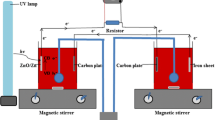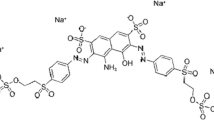Abstract
Cathode in photocatalytic fuel cell (PFC) plays a crucial role in degradation of organic contaminants. In this study, synthesized copper oxide (CuO) was loaded on carbon plate and used as photocathode in PFC for degradation of synthetic azo dye Reactive Black 5 (RB5) and real textile wastewater. Morphology and structural phase of the synthesized CuO were analyzed using scanning electron microscopy (SEM) and X-ray diffraction (XRD), respectively. Several operating parameters had been investigated such as light irradiation, initial dye concentration, and pH of azo dye solution within 6 h of irradiation time. The lowest initial concentration of RB5 (10 mg L−1) achieved 100% color removal compared to the highest initial concentration (40 mg L−1) which only achieved 77.1% color removal within 6 h of irradiation time. The influence of external resistance was significant in electricity generation but trivial in dye degradation efficiency. The external resistance of 6000 Ω yielded highest maximum power density, with Pmax of 0.2631 μW cm−2, followed by 1000 Ω (0.2196 μW cm−2) and 8000 Ω (0.1587 μW cm−2), respectively. The real textile wastewater with dilution ratio (DR) 1:6 yielded the highest energy conversion efficiency, η (3.62%), followed by DR 1:4 (3.19%) and DR 1:2 (1.96%), respectively.











Similar content being viewed by others
Availability of data and materials
All data generated or analyzed during this study are included in this published article.
References
Alaraj M, Radenkovic M, Park J (2017) Intelligent energy harvesting scheme for microbial fuel cells: maximum power point tracking and voltage overshoot avoidance. J Power Sources 342(1):726–732
Ali AH, Naser GF, Alkaim AF (2018) Treatment of textile industrial wastewater by advanced oxidation process. J Eng Appl Sci 13(5):1042–1045
Antolini E (2012) Graphene as a new carbon support for low temperature fuel cell catalyst. Appl Catal b: Environ 123–124:52–68
Antoniadou M, Kondarides ID, Labou D, Neophytides S, Lianos P (2010) An ffficient photoelectrochemical cell functioning in the presence of organic wastes. Sol Energy Mater Sol Cells 94(3):592–597
Aroob S, Taj MB, Shabbir S et al (2021) In situ biogenic synthesis of CuO nanoparticles over graphene oxide: a potential nanohybrid for water treatment. J Environ Chem Eng 9:105590
Babu SG, Karthik P, John MC et al (2019) Synergistic effect of sono-photocatalytic process for the degradation of organic pollutants using CuO-TiO2/rGO. Ultrason Sonochem 50:218–223
Bai J, Wang R, Li Y et al (2016) A solar light driven dual photoelectrode photocatalytic fuel cell (PFC) for simultaneous wastewater treatment and electricity generation. J Hazard Mater 311:51–62
Bayod-Rújula AA (2019) Solar photovoltaics (PV). In: Calise F, D’Accadia MD, Santarelli M, Lanzini A, Ferrero D (eds) Solar hydrogen production: processes, systems and technologies, Academic Press, pp 237 – 295
Chen AH, Huang YY (2010) Adsorption of Remazol Black 5 from aqueous solution by the templated crosslinked-chitosan. J Hazard Mater 177:668–675
Chen CY (2009) Photocatalytic degradation of azo dye Reactive Orange 16 by TiO2. Water Air Soil Pollut 202:335–342
Chung WJ, Nguyen DD, Bui XT et al (2018) A magnetically separable and recyclable Ag-supported magnetic TiO2 composite catalyst: fabrication, characterization, and photocatalytic activity. J Environ Manage 213(1):541–548
Ganguly S, Das P, Bose M et al (2017) Sonochemical green reduction to prepare Ag nanoparticles decorated graphene sheets for catalytic performance and antibacterial application. Ultrason Sonochem 39:577–588
Gutierrez-Mata AG, Velazquez-Martínez S, Álvarez-Gallegps A, Ahmadi M, Hernández-Pérez JA, Ghanbari F, Silva-Martinéz S (2017) Recent overview of solar photocatalysis and solar photo-Fenton processes for wastewater treatment. Int J Photoenergy 2017:1–27
Jung N, Chung DY, Ryu J, Yoo SJ, Sung YE (2014) Pt-based nanoarchitecture and catalyst design for fuel cell applications. Nano Today 9:433–456
Khalik WF, Ho LN, Ong SA, Voon CH, Wong YS, Yusoff NA, Lee SL, Yusuf SY (2017) Optimization of degradation of Reactive Black 5 (RB5) and electricity generation in solar photocalaytic fuel cell system. Chemosphere 184:112–119
Koe WS, Lee JW, Chong WC, Pang YL, Sim LC (2020) An overview of photocatalytic degradation: photocatalysts, mechanisms, and development of photocatalytic membrane. Environ Sci Pollut Res 27:2522–2565
Konstantinou IK, Albanis TA (2004) TiO2-assisted photocatalytic degradation of azo dyes in aqueous solution: kinetic and mechanistic investigations: a review. Appl Catal B 49:1–14
Lan S, Ju F, Wu X (2012) Treatment of wastewater containing EDTA-Cu(II) using the combined process of interior microelectrolysis and Fenton-oxidation-coagulation. Sep Purif Technol 89:117–124
Lianos P (2011) Production of electricity and hydrogen by photocatalytic degradation of organic wastes in a photoelectrochemical cell: the concept of the photofuel cell: a review of re-emerging research field. J Hazard Mater 185:575–590
Liu H, Wu X, Li X, Wang J, Fan X (2014) Simple preparation of scale-like CuO nanoparticles coated on tetrapod-like ZnO whisker photocatalysts. Chinese J Catal 35:1997–2005
Liu Y, Liu L, Yang F (2016) Energy-efficient degradation of Rhodamine B in a LED illuminated photocatalytic fuel cell with anodic Ag/AgCl/GO and cathodic ZnIn2S4 catalysts. R Soc Chem 6(15):12068–12075
Mariaswamy AJ, Ong SA, Abdul Rani AL, Ho LN (2020) Comparison of different cathode materials for degradation of Reactive Red 120 and electricity generation in photocatalytic fuel cell. Water Air Soil Pollut 231:522
Meng Xd, Zhen C, Liu G, Cheng HM (2022) Stabilizing CuO photocathode with a Cu3N protection shell. Chinese J Catal 43:755–760
Neppolian A, Choi HS, Sakthivel S, Arabindoo B, Murugesan V (2002) Solar/UV-induced photocatalytic degradation of three commercial textile dyes. J Hazard Mater B89:303–317
Pandey A, Singh P, Iyengar L (2007) Bacterial decolorization and degradation of azo dyes. Int Biodeter Biodegr 59:73–84
Pinto RP, Srinivasan B, Guiot SR, Tartakovsky B (2010) The effect of real-time external resistance optimization on microbial fuel cell performance. Water Res 45(4):1571–1578
Pourbabaee AA, Malekzadeh F, Sarbolouki MN, Najafi F (2006) Aerobic decolorization and detoxification of a disperse dye in textile effluent by a new isolate of Bacillus sp. Biotech Bioeng 93:631–635
Reza KM, Kurny ASW, Gulsham F (2017) Parameters affecting the photocatalytic degradation of dyes using TiO2: a review. Appl Water Sci 7:1569–1578
Thor SH, Ho LN, Ong SA, Abidin CZA, Heah CY, Nordin N, Ong YP, Yap KL (2021) Advanced oxidation treatment of amaranth dye synchronized with electricity generation using carbon-based cathodes in a sustainable photocatalytic fuel cell integrated electro-fenton system. J Environ Chem Eng 9:106439
Vinothkumar P, Manoharan C, Shanmugapriya B, Bououdina M (2019) Effect of reaction time on structural, morphological, optical and photocatalytic properties of copper oxide (CuO) nanostructures. J Mater Sci Mater Electron 30(6):6249–6262
Wang L, Wu J (2021) A review of recent progress in silver silicate-based photocatalysts for organic pollutant degradation. Inorg Chem Commun 129:108619
Wang SB, Hsiao CH, Chang SJ, Lam KT, Wen KH, Hung SC, Young SJ, Huang BR (2011) A CuO nanowire infrared photodetector. Sens Actuator a: Phys 171:207–211
Wang W, Jiang J, Zhang C, Zhao Q, Wang V, Lv J (2022) Micro-electricity utilization performance and microbial mechanism in microbial fuel cell powered electro-Fenton system for azo dye treatment. Biochem Eng J 186:108583
Wu Z, Zhao G, Zhang Y, Liu J, Zhang Y-n, Shi H (2015) A solar-driven photocatalytic fuel cell with dual photoelectrode for simultaneous wastewaetr treatment and hydrogen production. J Mater Chem A 3:3416–3424
Xu X, Cheng Y, Zhang T, Ji F, Xu X (2016) Treatment of pharmacutical wastewater using interior micro-electrolysis/Fenton oxidation-coagulation and biological degradation. Chemosphere 152:23–30
Ye J, Liu S-Q, Liu W-X, Meng Z-D, Chen F, Zhou J (2019) Photocatalytic simultaneous removal of nitrite and ammonia via a zinc ferrite/activated carbon hybrid catalyst under UV-visible irradiation. ACS Omega 4:6411–6420
Ying D, Peng J, Xu X, Li K, Wang Y, Jia J (2012) Treatment of mature landfill leachate by internal micro-electrolysis integradted with coagulation: a comparative study on a novel sequencing batch reactor based on zero valent iron. J Hazard Mater 229–230:426–433
Yu Z, Moussa H, Liu M, Schneider R, Moliere M, Liao H (2019) Heterostructured metal oxides-ZnO nanorods films prepared by SPPS route for photodegradation applications. Surf Coat Technol 375(7):670–680
Zhang L, Xia Z (2011) Mechanisms of oxygen reduction reaction on nitrogen-doped graphene for fuel cells. J Phys Chem C 115:11170–11176
Zhang L, Yin X, Li SFY (2015) Bio-electrochemical degradation of paracetamol in a microbial fuel cell-Fenton system. Chem Eng J 276:185–192
Zhang Z, Peng B, Ouyang X et al (2022) A self-powered photoelectrochemical aptasensor based on dual-photoelectrode photofuel cell for chloramphenicol detection. Sens Actuators B Chem 368:132144
Zhang Z, Wang P (2012) Highly stable copper oxide composite as an effective photocathode for water splitting via a facile electrochemical synthesis strategy. J Mater Chem 22:2456–2464
Acknowledgements
The authors would like to acknowledge that this research project was supported by the postdoctoral research grant (Grant no. 9001-00723) provided by the University Malaysia Perlis.
Funding
The funding is provided by the University Malaysia Perlis through postdoctoral research grant (Grant no. 9001–00723).
Author information
Authors and Affiliations
Contributions
WFK: methodology, visualization, writing — original draft preparation. L-NH: supervision, conceptualization, writing — review and editing. S-AO: project administration. N-BL: validation. S-HT: validation. K-LY: validation.
Corresponding author
Ethics declarations
Ethical approval
Not applicable.
Consent to participate
Not applicable.
Consent to publish
Not applicable.
Competing interests
The authors declare no competing interests.
Additional information
Responsible Editor: Guilherme L. Dotto
Publisher's note
Springer Nature remains neutral with regard to jurisdictional claims in published maps and institutional affiliations.
Supplementary Information
Below is the link to the electronic supplementary material.
Rights and permissions
Springer Nature or its licensor (e.g. a society or other partner) holds exclusive rights to this article under a publishing agreement with the author(s) or other rightsholder(s); author self-archiving of the accepted manuscript version of this article is solely governed by the terms of such publishing agreement and applicable law.
About this article
Cite this article
Khalik, W.F., Ho, LN., Ong, SA. et al. Converting synthetic azo dye and real textile wastewater into clean energy by using synthesized CuO/C as photocathode in dual-photoelectrode photocatalytic fuel cell. Environ Sci Pollut Res 30, 58516–58526 (2023). https://doi.org/10.1007/s11356-023-26589-y
Received:
Accepted:
Published:
Issue Date:
DOI: https://doi.org/10.1007/s11356-023-26589-y




